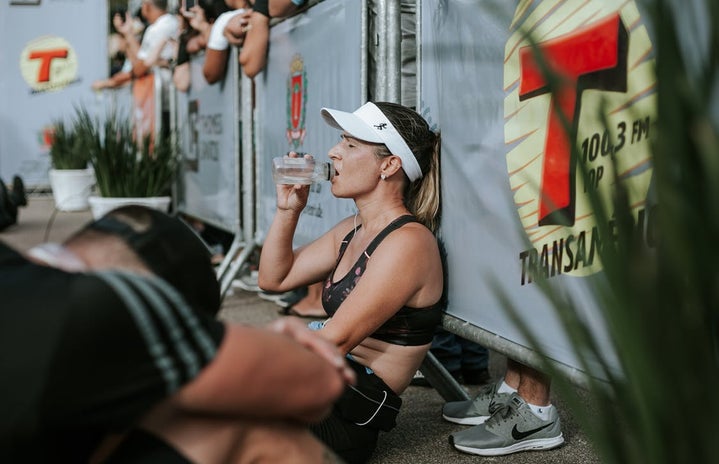1. Diet and hydration
It’s important to think about what you might eat before a run- especially if you’re going to try running fast. You may not want to have a glass of milk (or much dairy) an hour before running. The same thing goes for citrus, especially if you haven’t had anything else with your daily morning orange or grapefruit (trust me- I learned the hard way).
Besides those two things it doesn’t really matter what you eat, be it chipotle (delivered now of course) or some nuts. Though some people say that certain foods will help fuel you better for your run. This is usually just things with mostly fats and carbs.
This would be things like: Peanut butter toast, bananas, Avocado toast, oatmeal and berries, or a protein bar.
Protein is important too, but it is more important for your post-run meal!
Hydration is also incredibly important, especially with summer fast approaching (though it may not feel like it). Make sure to drink at least half your body weight in ounces a day. This is usually about 62 ounces of water a day, just to be safe.
Water will not only help keep you hydrated and healthy but will help energize you, keep your joints lubricated, help oxygen flow, and help stress on your body (drinking enough water means one less thing your body needs to remind you to do, so it can focus on other things).
Bonus: if you want to get super into running, you can take an iron supplement to really help increase oxygen flow and improve your running (Note that this will NOT help right away).
2. Form
Your running form is incredibly important for your runs. You don’t want to be running like you walk (heel-toe, heel toe). There’s a reason we had to do form drills in cross country.
You will want to have your toes pointed up, and have the ball of your foot be the first thing you land on.
You want your back straight, with your shoulders way from your ears- no hunching over or looking down at the ground! Look in front of you, towards your goal! That being said, you will want your torso and hips to be slightly leaning into your run.
You’ll want your arms at 90 degrees, and make sure to move them! Moving your arms in coordination with your body will help you all over- including going faster.
Make sure your hands are relaxed. Many people do different things with their hands as they run. I like to keep mine in loose fists. No need to waste energy by squeezing your hands! That being said, if you have one or can invest in one, use an armband for your phone (if you bring it on runs).
To get more detail on proper form, read this article! Having good form will help keep you from getting injured!
Bonus: your shoes can dramatically help your runs. If you’re finding your ankles hurt, your shins hurt, or you have had your shoes for a year or two, it may be a good idea to invest in some better shoes. Some people like less support and some like more. I personally like more support. Asics are solid shoes, but I’ve just switched to HOKA after having serious shin pain. I improved my mile time by nearly a minute with more support. It’s all about what works best for you.
3. Warm-up
Warming up is ESSENTIAL for avoiding injury.
There are a couple components to warming up. First you’ll want to stretch out DYNAMICALLY. This means you aren;t just staying in one spot and stretching, but rather moving while stretching. A good example would be walking luncges- you can stretch out your hips while warming up your muscles.
Dynamic stretching usually goes along with the exercise you’re about to do. For example, for running you’ll want to do lots of movements involving your legs. This will help avoid injury because you’re getting your body moving and ready to workout.
check out more, along with some examples in this article!
Along with dynamic stretching, you’re going to want to do at least a 5 to 10-minute warm-up. This would be a light jog to really get your body ready.
Your body will thank you for warming up
4. Different Kinds of Runs
Your types of runs will help you get better overall, and each are important for getting better.
Timed: these runs will be where you try to see your improvement. Whether you’re trying to start running a 5k or just improving a mile time. For these runs, start a timer or watch right when you begin. If you don’t use a watch to tell you how far you have gone, try using google maps to plan out a run. Once you know where you’re running, or have something to tell you how far you have gone, start and go as fast as you can for your desired amount!
Timed runs are great for your first run too. This way you can track your progress from the beginning. I would recommend doing a timed one mile run as your first timed run. This way you can know your baseline, and work up to doing more miles at the same pace, rather than slowing down. This is where your endurance will come in.
-Endurance: these runs will be long runs. Depending on your level, a long run could mean 10 minutes or 70. As you go on, you can work up to doing longer and longer runs.
These kinds of runs are nice because you can also run for a certain amount of miles as a long run. For a beginner, a long run could be two miles, and for someone more experienced, a long run could be 10 to 12.
Endurance runs will help increase your muscular endurance, which will help when you are trying to run that 5k faster. This happens because it uses your aerobic system, which helps increase how your body delivers oxygen to your muscles (including helping breathing efficiency).
Note: if you notice any stiffness in your neck/ back during these runs, you may not be running properly.
Sprints: These are great to pair with your timed runs, or have as a workout on its own. ( If you do choose to do it as it’s own exercise, make sure you do a light 5-minute warm-up run so you don’t hurt yourself sprinting)
For sprints, you’ll want to start with timed sprints (especially if you don’t have a watch to track distance). Sprints can be defined as 10-30 seconds of hard work (or running as fast as you can). To really improve your running, you don’t want to wait until you have fully caught your breath until you go again- get mostly there, but not totally.
You can repeat sprints anywhere from 5 to about 12 times. And if you really want to increase your running ability, do your sprints by starting off in a jog, sprinting, and then jogging a to catch your breath. If you’re not quite there yet- that’s okay! Running builds over time.
You can read more about these runs here!
Bonus: Focus on your breathing during all types of running. Try not to huff and puff, and certainly don’t hold your breath (you’d be surprised how many people hold their breath during certain movements of exercise). Focus on breathing as deep as you can. Breathing through your nose and out your mouth is also extremely beneficial.
5. To Listen to Music or to Not Listen to Music
Music is an incredible way to help you get through a run. It can help the perception of how tired you are. Running in synchrony with the BPM can also help you run faster (or maybe slower for distance).
Music can be very very motivating! I certainly love having a full playlist of fast-paced songs.
That being said there are also benefits to running without music.
The biggest one is safety. Running outside can be distracting in itself, and you’ll want to be able to hear cars, cyclists and other people coming. (Bonus: when running outside, run on the side of the road where oncoming traffic will see you best. Don’t run around a curb on the side the car will be coming at you. You don’t want to have someone who is speeding around it run into you).
Running without music can also allow you time to reflect on yourself and just relax from your day.
6. Outside vs Inside
Right now, most people are probably running outside, unless you own a treadmill. That being said, there is an incredible difference between running inside and outside. You could be running amazingly inside, but once you step outside, your ability will not be the same.
If you’re training to do a 5k or even a marathon, you will want to run outside. Even if you aren’t training for one of those, running outside is more beneficial overall.
Running outside gives you fresh air, vitamin D from the sun, and it is better for relaxation. It is also harder to run outside, because you are doing every aspect of work as opposed to a treadmill. Plus, when you are outside, while you can still stop running, you’ll probably have to walk back to your house if you do instead of going and sitting on the couch.
I find the outdoor much more motivating (and free!)
If you run inside, you will still get work done, and that’s totally fine! maybe you don’t have a safe spot to run but you have a treadmill, or you’ve got to take care of someone and can’t fully leave the house right now! That’s totally fine! All the rules still apply to running inside as they do outside (maybe besides the music part). If you are training to run something like a 5k outside but can only be on a treadmill at the moment, I would consider running a little longer, or a little faster. Try to really fatigue yourself. You can even put the treadmill on a slight incline.
7. Post Running Care
Post running care is ESSENTIAL! Especially if you are new to running. You’re going to want to make sure you’re fully stretching after your runs. I stretch twice- right after my workout, and a little bit before bed. You should also be stretching more on your off days.
Leg swings are perfect for right after running. While holding a hand against a wall, swing one of your legs from side to side, as well as forwards and backward. Do this for both legs, and about 20 times each way. Here is a video on that!
Having things like chocolate milk (almond and oat work too) after a run is a classic, and always encouraged. Try having a meal or snack with some good protein in it after as well. If you aren’t planning to eat a meal right after, a good snack after your run/workout is essential to get your body into repair mode with good vitamins, proteins, fats, and carbs.
If you’re finding yourself sore while beginning your running journey, don’t be discouraged! It’s good! A couple things that will help get rid of the soreness
– A foam roller or a regular roller will really be able to help move the lactic acid, and get rid of any knots in your muscles.
-Ice cups are a staple of running. If you have any kind of dixie cups, fill them with water and freeze them over night. After a run, pull one out and rub the ice up and down your legs. (If you’re very sore in one part, you can ice that part more)
-Cold shower/ bath for your legs if you hate both of these, you can just do the ice cups! Ice/cold is super important for helping recovering muscles.
-Sitting without legs up vertically against the wall will really help move that lactic acid as well. Put your butt against the wall, with your legs up against it for a good 15 minutes.
-KT tape can be great for strained muscles or anyone with a past injury. Some people love it and some don’t- I personally am in the middle but you may love it!
Whether you just need a goal to work towards, you need to get out of the house, or you need stress relief during these times, running can be super great for you.
Just remember running takes time to build up, and you lose it super fast. So don’t get upset with yourself if it takes a while to see improvement. Keep track of your progress whether you write it down, or you have a watch to keep track for you.
Also, apps like Couch to 5k have been great for having a schedule to run. If you find yourself just bored when you run, I would try to find a good running app l like Zombies Run (a personal fave). I find that apps can be super helpful for having more structure rather than just going day by day.
Most importantly, don’t forget to cheer yourself on!
Happy running!


